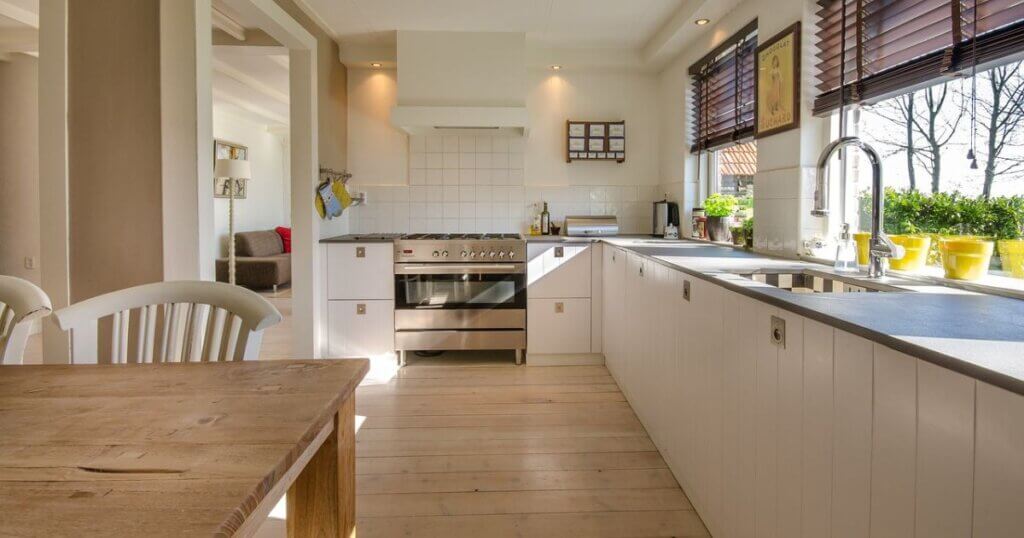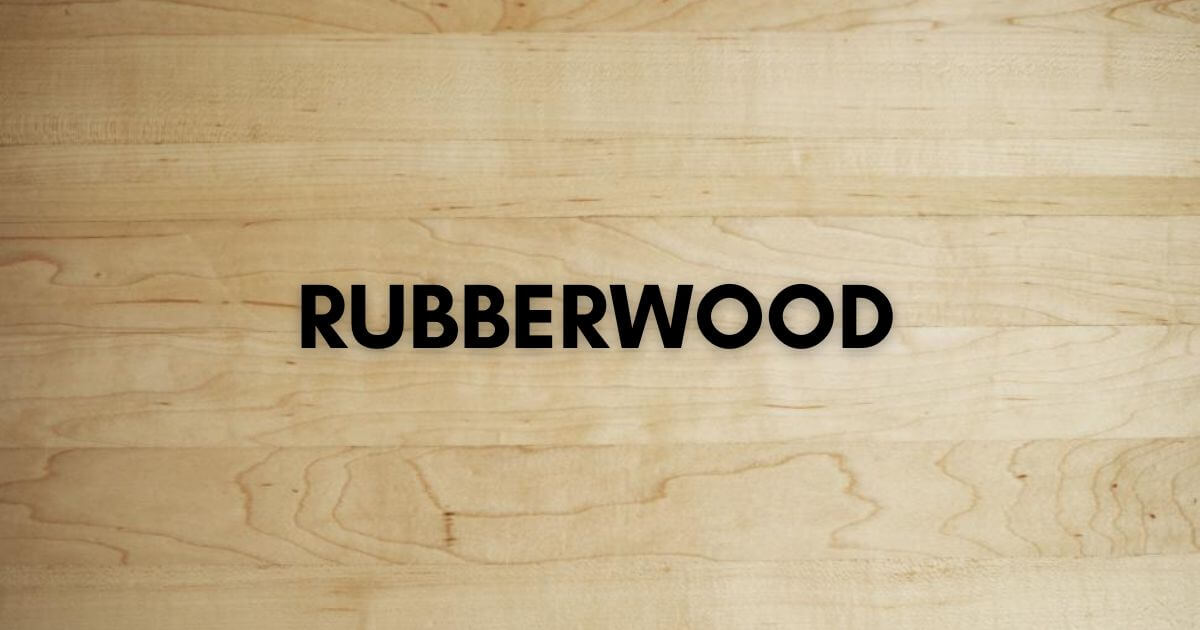Rubberwood is a light-colored, medium-durable hardwood from the small to medium size rubber tree. The rubber tree is mainly cultivated for rubber production. Rubberwood has unique properties, which makes it popular in a variety of industries.
Rubberwood is also known as plantation hardwood, parawood, and Malaysian oak. It is native to Brazil, Venezuela, Ecuador, Colombia, Peru, and Bolivia.
Characteristic of Rubberwood
| Scientific name | Hevea brasiliensis |
| Tree Size | 50-100 ft (15-30 m) tall, 1-3 ft (.3-1 m) trunk diameter |
| Average Dried Weight | 37 lbs/ft3 (595 kg/m3) |
| Janka Hardness | 960 lbf (4,280 N) |
| Crushing Strength | 6,110 lbf/in2 (42.1 MPa) |
| Shrinkage: Radial | 2.3%, Tangential: 5.1%, Volumetric: 7.5%, T/R Ratio: 2.2 |
| Types | Hardwood |
What Is Rubberwood Used For?
Rubberwood is mainly used for interior furniture as it is moderately durable and not great for outdoor environments. Here are the most common uses for rubberwood.

Furniture
Rubberwood is widely used in indoor furniture. Its light color and straight grain makes it easy to stain and finish. It is commonly used for making tables, chairs, cabinets, bed frames etc.
Flooring
Rubberwood flooring is becoming increasingly popular in recent years. It is a cost-effective, durable hardwood floor. Rubberwood flooring is known for its light and uniform color.
Cabinets
Rubberwood is known for its durability and stability. It finishes very well.
Paneling and moldings
Rubberwood is used to produce decorative paneling and moldings, adding an elegant touch to interior designs.
Plywood and veneer
Rubberwood is used to make plywood sheets for use in various applications. Plywood made from rubber wood is commonly used in construction, cabinetry, and furniture.
Carving and Decorative Items
Rubberwood is medium-density wood, making it easy to carve and shape. Wood is used for quality wooden items.
Appearance
Rubberwood is usually light-colored hardwood, ranging from pale yellowish-white to light cream. Sometimes there can be light or dark brown streaks as well. Like other hardwoods, it darkens over time when exposed to the air and sunlight.
Pros and Cons Of Rubberwood
Pros
- Appearance- Rubberwood is a light-colored hardwood. The light color of rubberwood allows for easy staining and finishing.
- Easy to Work- Another advantage of rubberwood is that it is easy to work with hand and machine tools. It can be easily cut, shaped and joined, making it easy for a beginner to work with wood.
- Durable- Rubberwood is considered a moderately durable wood, which makes it versatile for indoor purposes.
- Sustainable and Eco-friendly – Rubberwood is considered environmentally friendly because it comes from the rubber tree. When an old tree is no longer producing latex, the rubber tree is harvested for lumber, efficiently using the resource.
- Cost-effective- Rubberwood is generally available more cheaply than many other hardwoods, making it a cost-effective option for furniture and other wood-based products.
Cons
- Not for Outdoor – Rubberwood is a durable wood, but it is not suitable for outdoor purposes. Without proper sealing and finishing, it can be susceptible to damage from water, pests and fungal growth.
- Can Warp and twist- Rubberwood has open pores that allow it to hold a lot of moisture. So there is a high possibility that the wood can warp and twist while drying.
- Not Resistant to Rot- Rubberwood is highly susceptible to fungal and insect attacks, so it is not ideal for ground contact or damp purposes.
- Prone to denting and scratching: Rubberwood has a relatively soft hardwood, which is more prone to denting and scratching than other hardwoods. So it’s required care and maintenance to avoid heavy impact.
Workability
Generally, Rubberwood is easy to work with. It is medium-density and straight grain, making cutting, shaping, and joining easy. It doesn’t require pre-drilling before nailing or screwing.
It is medium weight, and uniform grain pattern makes it easy to handle and machine operations. Using the proper tools and techniques, Rubberwood can be easily worked with.
Hardness
Rubberwood is a medium-density hardwood. It has a Janka hardness value of 960 lbf (4,280 N) and an average dried weight of 37 lbs/ft3 (595 kg/m3).
Here’s a comparison table of Janka hardness values for rubberwood and a few other common wood species:
| Wood species | Janka Hardness |
| Sande | 810 lbf (3,620 N) |
| Honduran mahogany | 900 lbf (4,020 N) |
| Paper Birch | 910 lbf (4,050 N) |
| Rubberwood | 960 lbf (4,280 N) |
| Holly | 1,020 lbf (4,540 N) |
| Sweet Cherry | 1,150 lbf (5,120 N) |
| White oak | 1,350 lbf (5,990 N) |
Rot and Insects Resistant
Rubberwood is moderately rot-resistant. It is more susceptible to insect attack than naturally rot-resistant hardwoods such as teak or cedar.
Proper treatments and protective measures are recommended to increase resistance to rot and insects. Applying a preservative, sealant, or finish can be a great solution that provides a barrier against moisture and pests.
If you plan to use rubberwood in applications that may be exposed to moisture or potential insect activity, it is advisable to consult with wood treatment experts.
Price
Rubberwood is an affordable and cost-effective hardwood. Its cheapness is because it is extensively cultivated for latex production. Rubberwood is not considered to be a durable wood, so most people prefer to choose other woods like oak, maple or cherry.
Staining Rubberwood Furniture Step By Step
Generally, Rubberwood is easy to stain due to its light color and uniform texture. Staining Rubberwood furniture is a popular way to enhance its appearance.
Here is a step-by-step guide on how to stain rubberwood furniture:
Choose a perfect stain
Many stains are available in the market, but not all are suitable for all types of wood. An oil-based stain is perfect for rubberwood.
Prepare the work furniture
Before moving on to the next step of staining, the furniture’s surface must be prepared. Start with a light sanding to smooth the surface and open the wood pores. Sanding also removes the existing finish.
Apply Pre-Stain Wood Conditioner
Applying Pre-Stain Wood Conditioner before staining is necessary when the wood has open pores. Due to the open pores, the surface absorbs the stain quickly, which is responsible for the spotty stain.
Pre-Stain Wood Conditioner partially seals the open pores so that the wood gradually absorbs the stain. This process helps achieve a more uniform and even stain.
Apply Stain
Now it’s time to apply the stain. Start applying the stain in the direction of the grain of the wood. You can choose a brush, cloth, sponge, or sprayer. Rubberwood is light-colored, so you may need to apply double coats of stain.
Keep a gap of three to four hours between the first and second coat so that the surface of the wood dries properly.
Allow the stain to soak the wood according to the manufacturer’s directions. Oil-based stains usually take 12 to 24 hours to dry thoroughly.
Apply Stain Sealer or Finish
Applying sealer is an optional step, but experts recommend applying a sealer after the stain is completely dry. The sealer forms a protective layer over the stain and increases its durability.
FAQ
Is Rubberwood good for outdoor purposes?
Generally, Rubberwood is not recommended for outdoor purposes or exposure to outdoor environments. While it is a durable and stable wood for indoor applications, it is not naturally resistant to decay, moisture or insects. Rubberwood is prone to warping, splitting, and rotting when exposed to outdoor conditions.
Is Rubberwood Good for Carving?
Yes, Rubberwood can be used for carving. Generally, it is easy to carve and cut, but it is not the first choice for professional woodcarvers. There are many other popular wood species for carving, such as basswood, butternut, aspen, white pine, and black walnut, which is more popular for carving than Rubberwood.
Is Rubberwood Safe For Cutting Boards?
Yes, Rubber Wood is safe for making cutting boards. It is considered safe and non-toxic wood, meaning it does not contain any harmful chemicals that could leach into food.
However, as we know, rubberwood contains latex which no one would want to add to their food. But when the rubber tree becomes mature, it stops producing latex.
Is Rubberwood Waterproof?
No, Rubberwood is not waterproof. It is a moderately dense hardwood that is not naturally resistant to moisture and weather. However, it can be used in moist places for a short time after proper sealing. But it cannot be made completely waterproof by any method.


